FORD TRANSIT CONNECT 2011 1.G Owner's Guide
Manufacturer: FORD, Model Year: 2011, Model line: TRANSIT CONNECT, Model: FORD TRANSIT CONNECT 2011 1.GPages: 295, PDF Size: 2.23 MB
Page 31 of 295
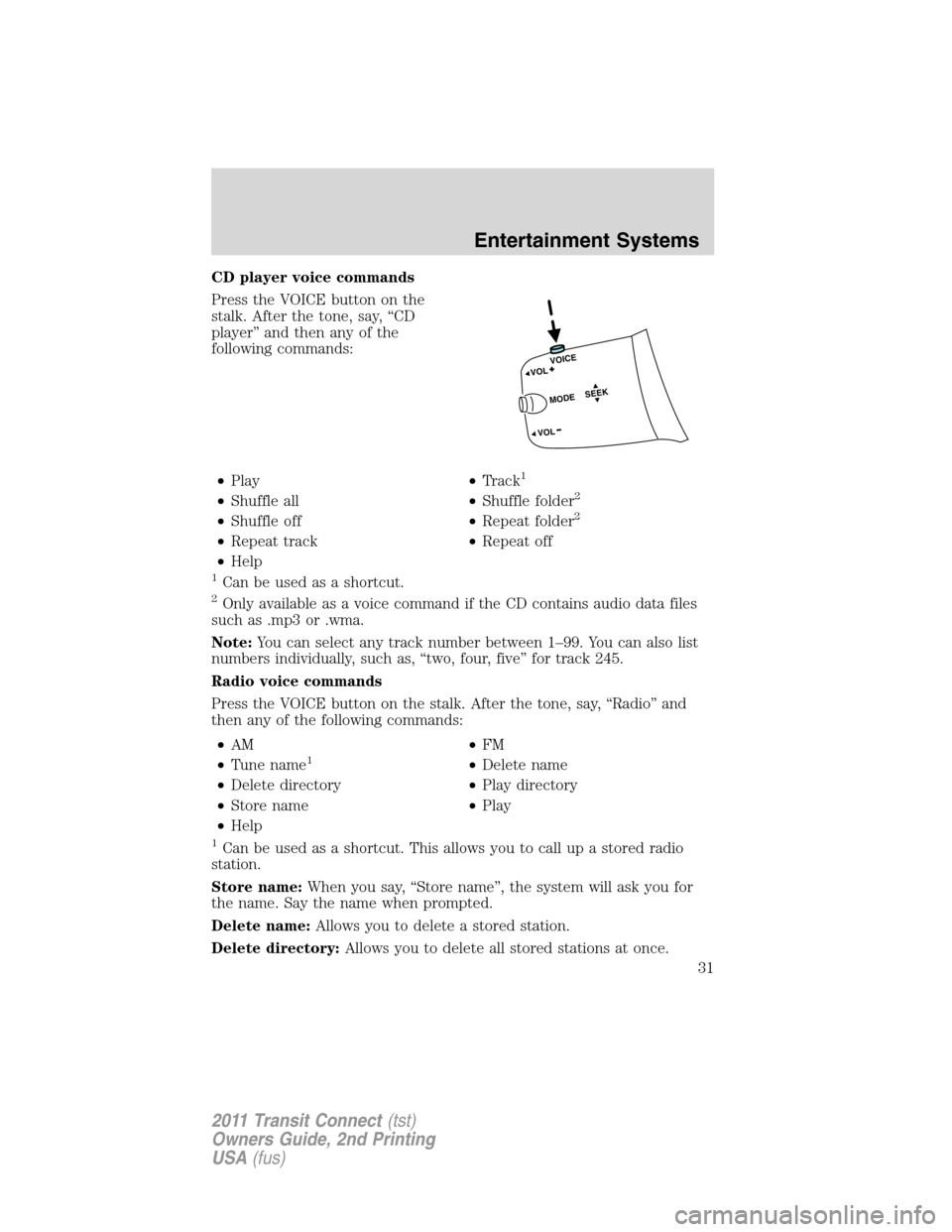
CD player voice commands
Press the VOICE button on the
stalk. After the tone, say, “CD
player” and then any of the
following commands:
•Play•Track
1
•Shuffle all•Shuffle folder2
•Shuffle off•Repeat folder2
•Repeat track•Repeat off
•Help
1Can be used as a shortcut.2Only available as a voice command if the CD contains audio data files
such as .mp3 or .wma.
Note:You can select any track number between 1–99. You can also list
numbers individually, such as, “two, four, five” for track 245.
Radio voice commands
Press the VOICE button on the stalk. After the tone, say, “Radio” and
then any of the following commands:
•AM•FM
•Tune name
1•Delete name
•Delete directory•Play directory
•Store name•Play
•Help
1Can be used as a shortcut. This allows you to call up a stored radio
station.
Store name:When you say, “Store name”, the system will ask you for
the name. Say the name when prompted.
Delete name:Allows you to delete a stored station.
Delete directory:Allows you to delete all stored stations at once.
VOICE
SEEK
VOL
VOL
MODE
Entertainment Systems
31
2011 Transit Connect(tst)
Owners Guide, 2nd Printing
USA(fus)
Page 32 of 295
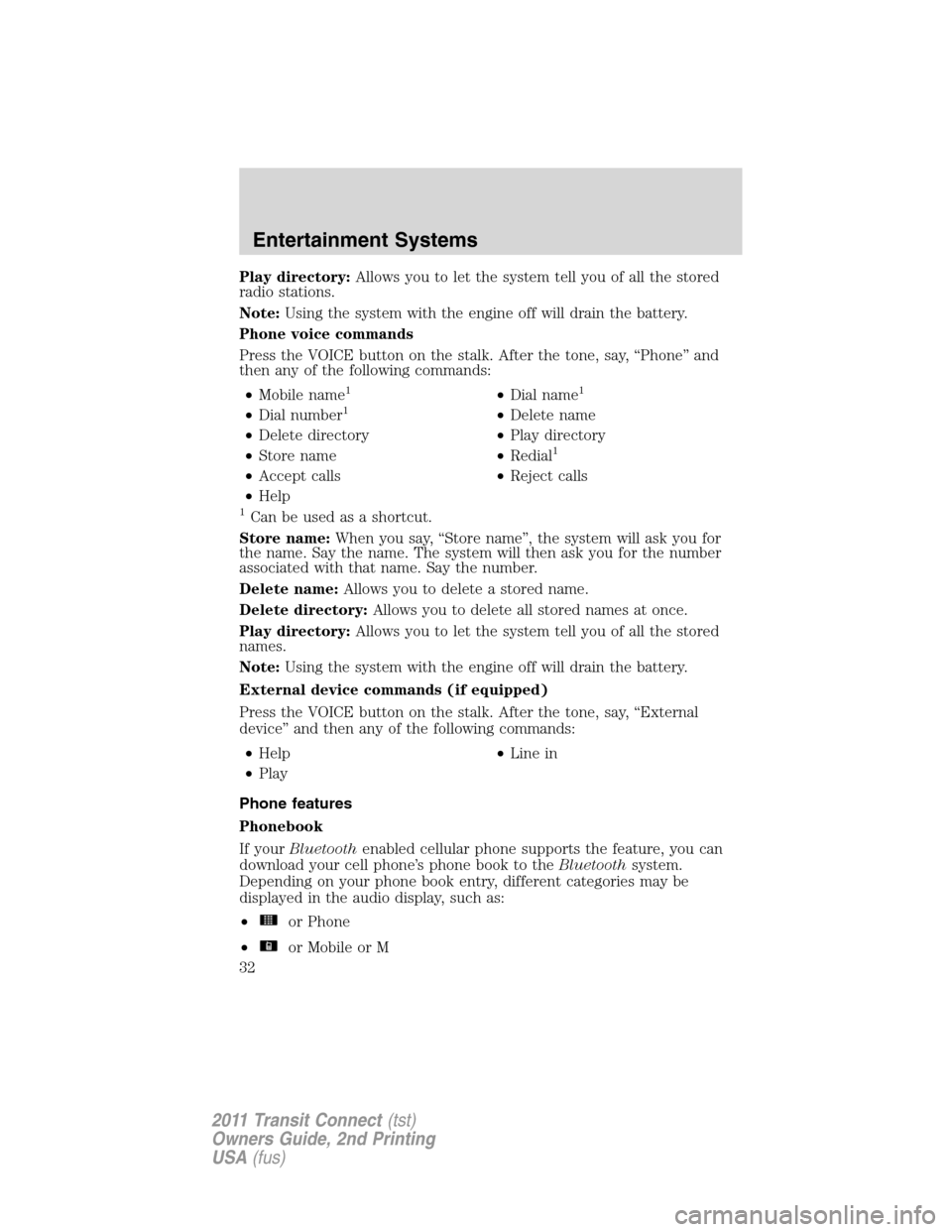
Play directory:Allows you to let the system tell you of all the stored
radio stations.
Note:Using the system with the engine off will drain the battery.
Phone voice commands
Press the VOICE button on the stalk. After the tone, say, “Phone” and
then any of the following commands:
•Mobile name
1•Dial name1
•Dial number1•Delete name
•Delete directory•Play directory
•Store name•Redial
1
•Accept calls•Reject calls
•Help
1Can be used as a shortcut.
Store name:When you say, “Store name”, the system will ask you for
the name. Say the name. The system will then ask you for the number
associated with that name. Say the number.
Delete name:Allows you to delete a stored name.
Delete directory:Allows you to delete all stored names at once.
Play directory:Allows you to let the system tell you of all the stored
names.
Note:Using the system with the engine off will drain the battery.
External device commands (if equipped)
Press the VOICE button on the stalk. After the tone, say, “External
device” and then any of the following commands:
•Help•Line in
•Play
Phone features
Phonebook
If yourBluetoothenabled cellular phone supports the feature, you can
download your cell phone’s phone book to theBluetoothsystem.
Depending on your phone book entry, different categories may be
displayed in the audio display, such as:
•
or Phone
•
or Mobile or M
Entertainment Systems
32
2011 Transit Connect(tst)
Owners Guide, 2nd Printing
USA(fus)
Page 33 of 295
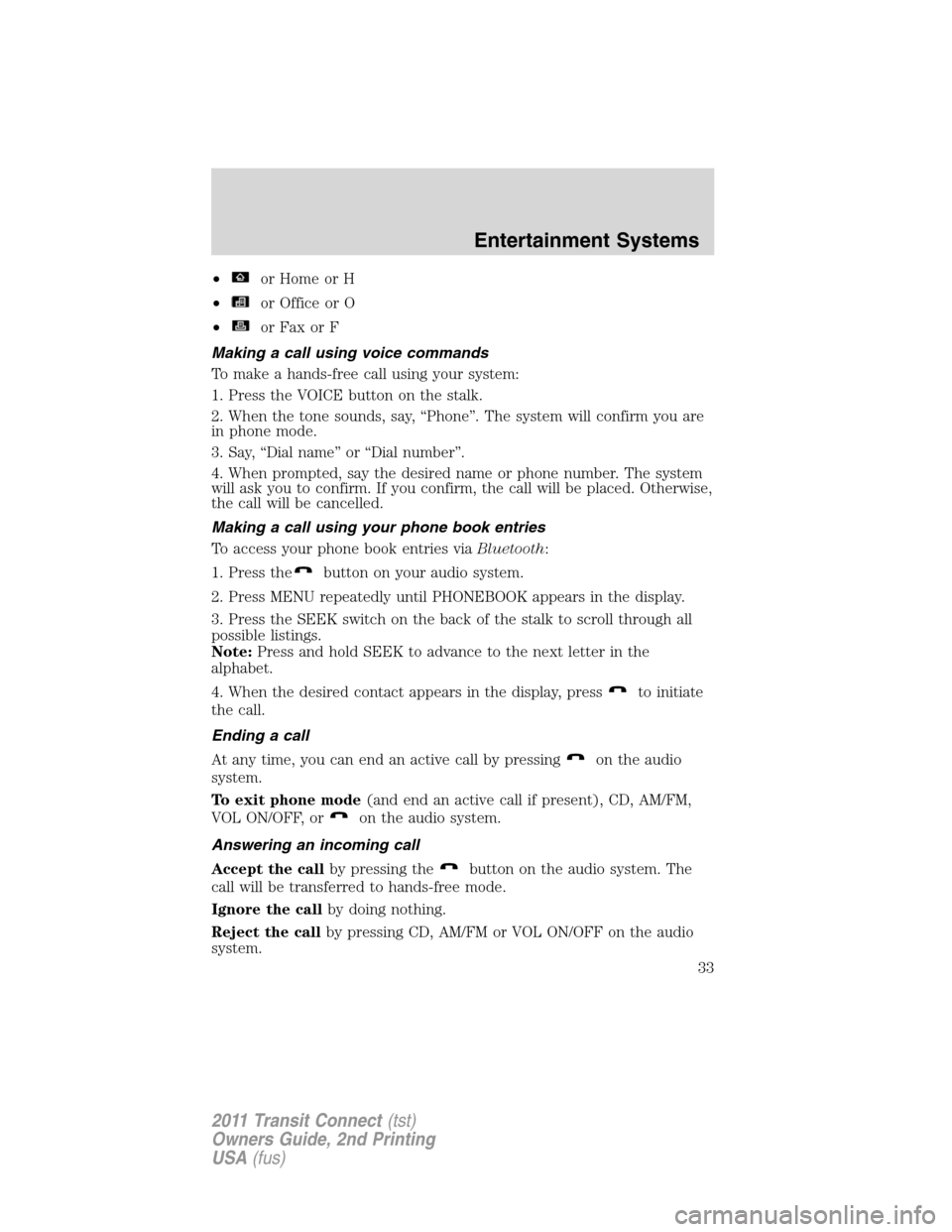
•or Home or H
•
or Office or O
•
or Fax or F
Making a call using voice commands
To make a hands-free call using your system:
1. Press the VOICE button on the stalk.
2. When the tone sounds, say, “Phone”. The system will confirm you are
in phone mode.
3. Say, “Dial name” or “Dial number”.
4. When prompted, say the desired name or phone number. The system
will ask you to confirm. If you confirm, the call will be placed. Otherwise,
the call will be cancelled.
Making a call using your phone book entries
To access your phone book entries viaBluetooth:
1. Press the
button on your audio system.
2. Press MENU repeatedly until PHONEBOOK appears in the display.
3. Press the SEEK switch on the back of the stalk to scroll through all
possible listings.
Note:Press and hold SEEK to advance to the next letter in the
alphabet.
4. When the desired contact appears in the display, press
to initiate
the call.
Ending a call
At any time, you can end an active call by pressing
on the audio
system.
To exit phone mode(and end an active call if present), CD, AM/FM,
VOL ON/OFF, or
on the audio system.
Answering an incoming call
Accept the callby pressing the
button on the audio system. The
call will be transferred to hands-free mode.
Ignore the callby doing nothing.
Reject the callby pressing CD, AM/FM or VOL ON/OFF on the audio
system.
Entertainment Systems
33
2011 Transit Connect(tst)
Owners Guide, 2nd Printing
USA(fus)
Page 34 of 295
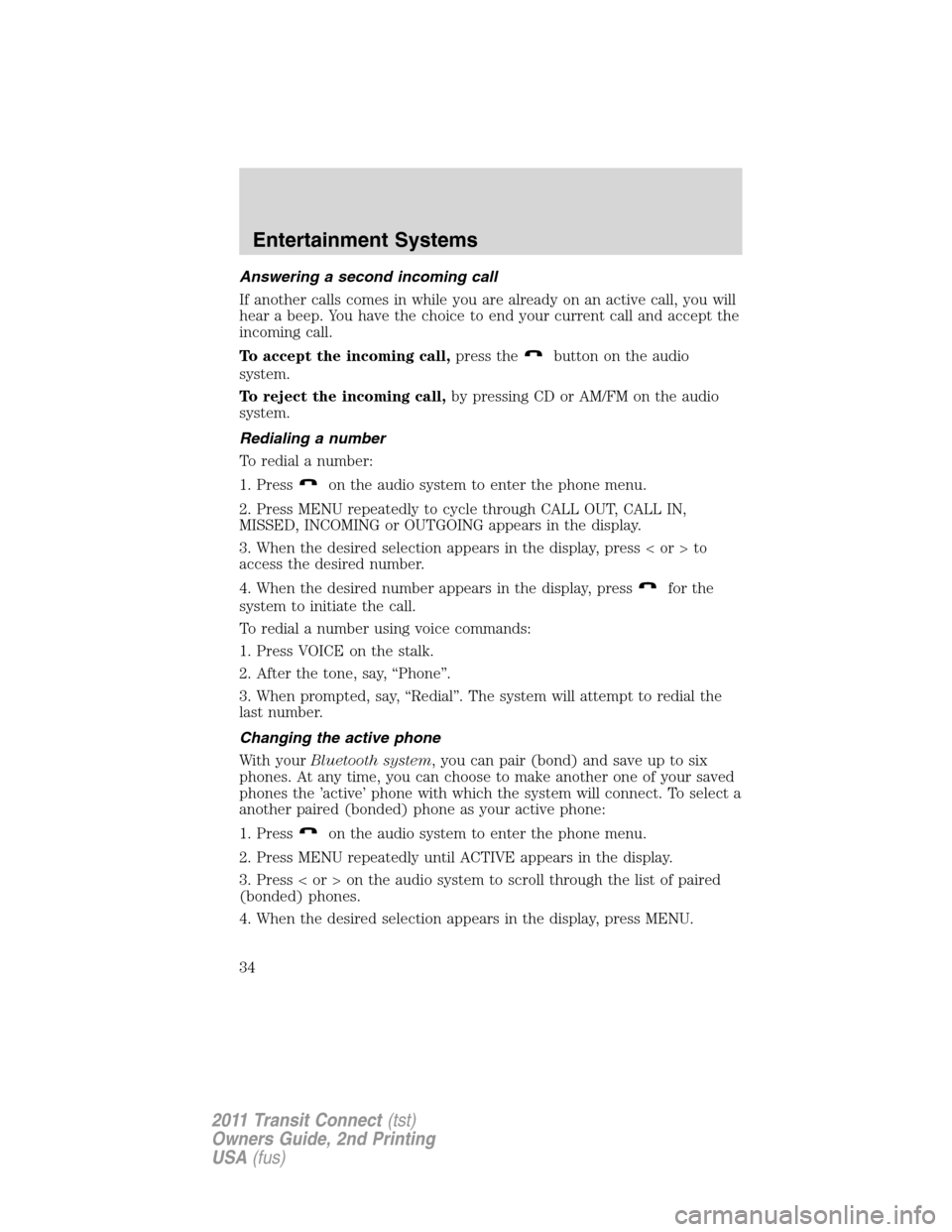
Answering a second incoming call
If another calls comes in while you are already on an active call, you will
hear a beep. You have the choice to end your current call and accept the
incoming call.
To accept the incoming call,press the
button on the audio
system.
To reject the incoming call,by pressing CD or AM/FM on the audio
system.
Redialing a number
To redial a number:
1. Press
on the audio system to enter the phone menu.
2. Press MENU repeatedly to cycle through CALL OUT, CALL IN,
MISSED, INCOMING or OUTGOING appears in the display.
3. When the desired selection appears in the display, press < or > to
access the desired number.
4. When the desired number appears in the display, press
for the
system to initiate the call.
To redial a number using voice commands:
1. Press VOICE on the stalk.
2. After the tone, say, “Phone”.
3. When prompted, say, “Redial”. The system will attempt to redial the
last number.
Changing the active phone
With yourBluetooth system, you can pair (bond) and save up to six
phones. At any time, you can choose to make another one of your saved
phones the ’active’ phone with which the system will connect. To select a
another paired (bonded) phone as your active phone:
1. Press
on the audio system to enter the phone menu.
2. Press MENU repeatedly until ACTIVE appears in the display.
3. Press < or > on the audio system to scroll through the list of paired
(bonded) phones.
4. When the desired selection appears in the display, press MENU.
Entertainment Systems
34
2011 Transit Connect(tst)
Owners Guide, 2nd Printing
USA(fus)
Page 35 of 295
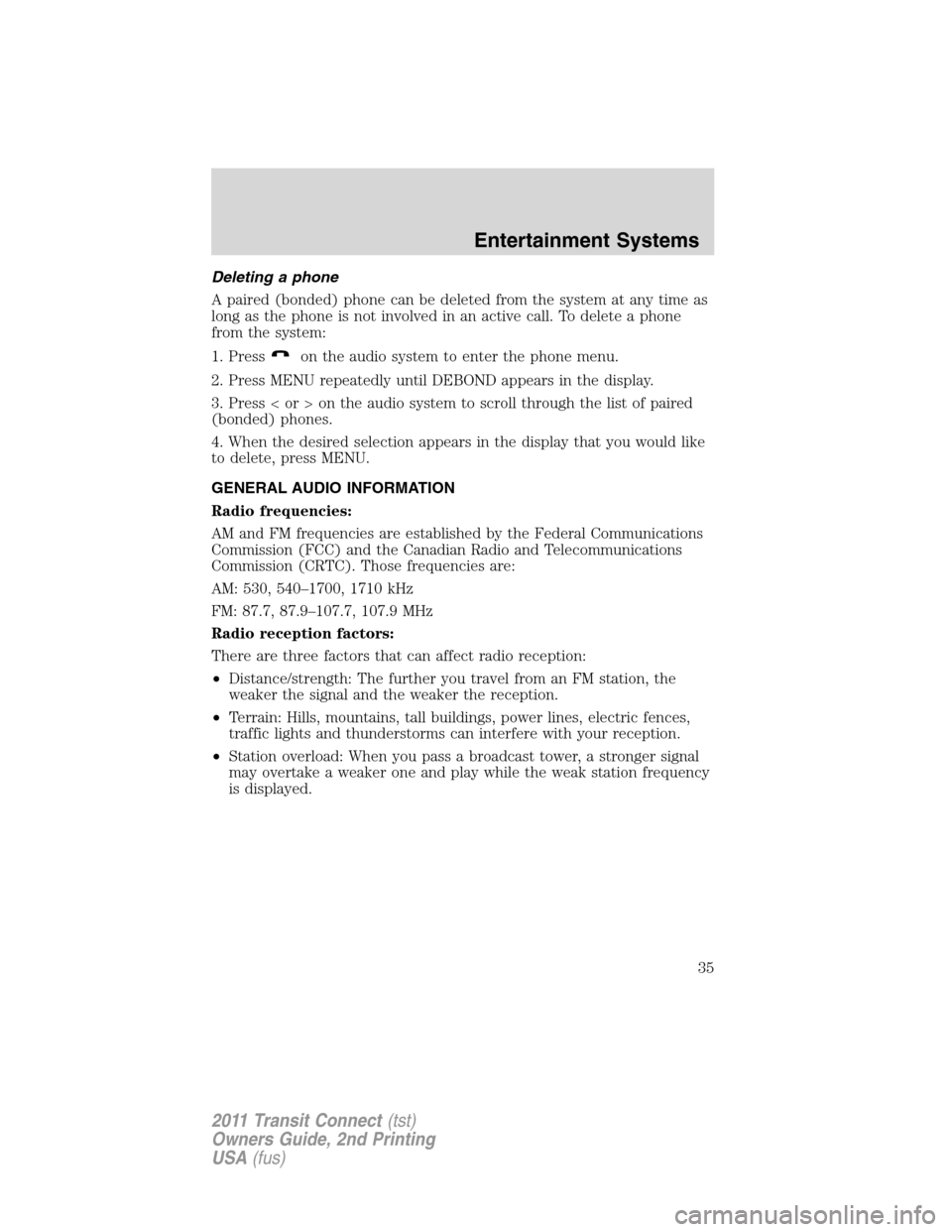
Deleting a phone
A paired (bonded) phone can be deleted from the system at any time as
long as the phone is not involved in an active call. To delete a phone
from the system:
1. Press
on the audio system to enter the phone menu.
2. Press MENU repeatedly until DEBOND appears in the display.
3. Press < or > on the audio system to scroll through the list of paired
(bonded) phones.
4. When the desired selection appears in the display that you would like
to delete, press MENU.
GENERAL AUDIO INFORMATION
Radio frequencies:
AM and FM frequencies are established by the Federal Communications
Commission (FCC) and the Canadian Radio and Telecommunications
Commission (CRTC). Those frequencies are:
AM: 530, 540–1700, 1710 kHz
FM: 87.7, 87.9–107.7, 107.9 MHz
Radio reception factors:
There are three factors that can affect radio reception:
•Distance/strength: The further you travel from an FM station, the
weaker the signal and the weaker the reception.
•Terrain: Hills, mountains, tall buildings, power lines, electric fences,
traffic lights and thunderstorms can interfere with your reception.
•Station overload: When you pass a broadcast tower, a stronger signal
may overtake a weaker one and play while the weak station frequency
is displayed.
Entertainment Systems
35
2011 Transit Connect(tst)
Owners Guide, 2nd Printing
USA(fus)
Page 36 of 295
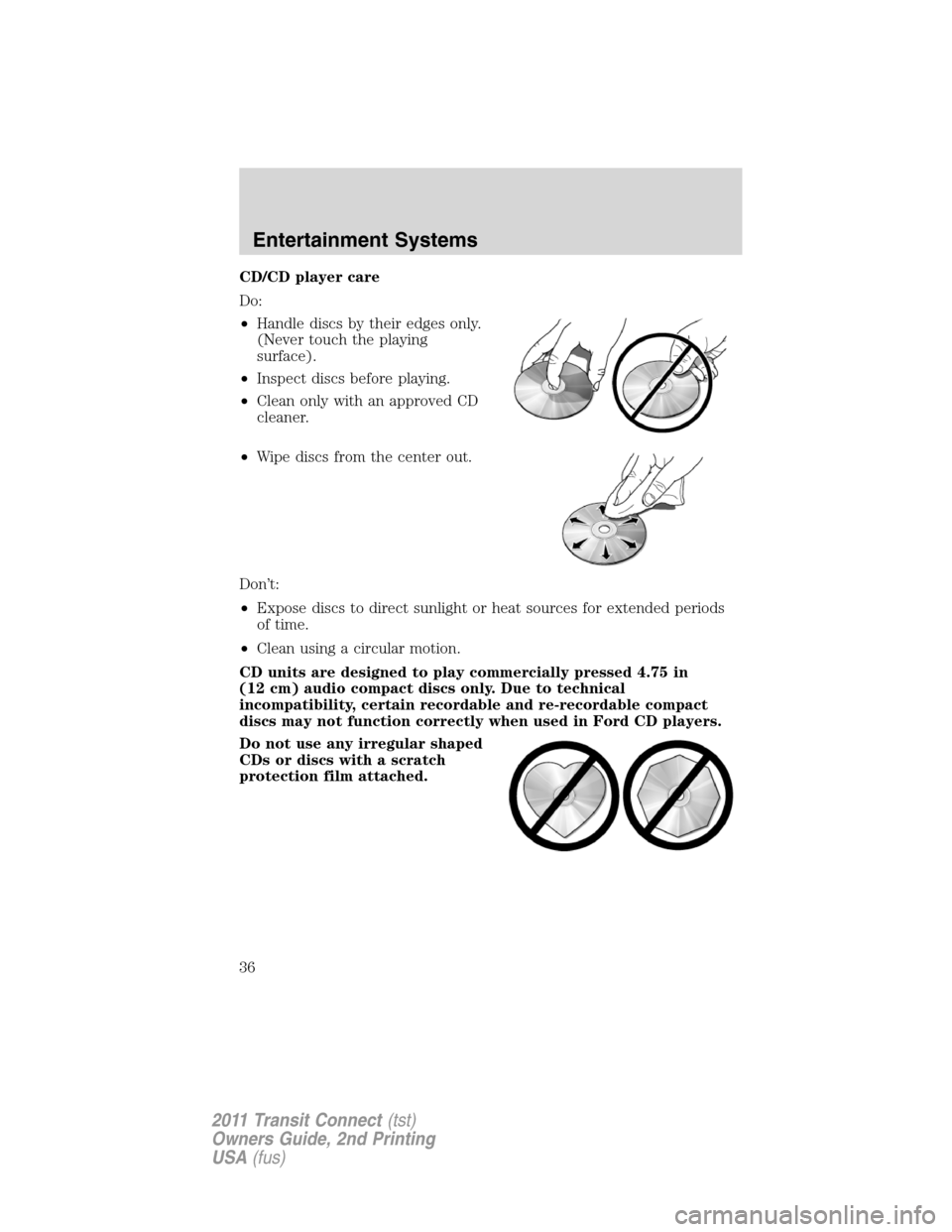
CD/CD player care
Do:
•Handle discs by their edges only.
(Never touch the playing
surface).
•Inspect discs before playing.
•Clean only with an approved CD
cleaner.
•Wipe discs from the center out.
Don’t:
•Expose discs to direct sunlight or heat sources for extended periods
of time.
•Clean using a circular motion.
CD units are designed to play commercially pressed 4.75 in
(12 cm) audio compact discs only. Due to technical
incompatibility, certain recordable and re-recordable compact
discs may not function correctly when used in Ford CD players.
Do not use any irregular shaped
CDs or discs with a scratch
protection film attached.
Entertainment Systems
36
2011 Transit Connect(tst)
Owners Guide, 2nd Printing
USA(fus)
Page 37 of 295
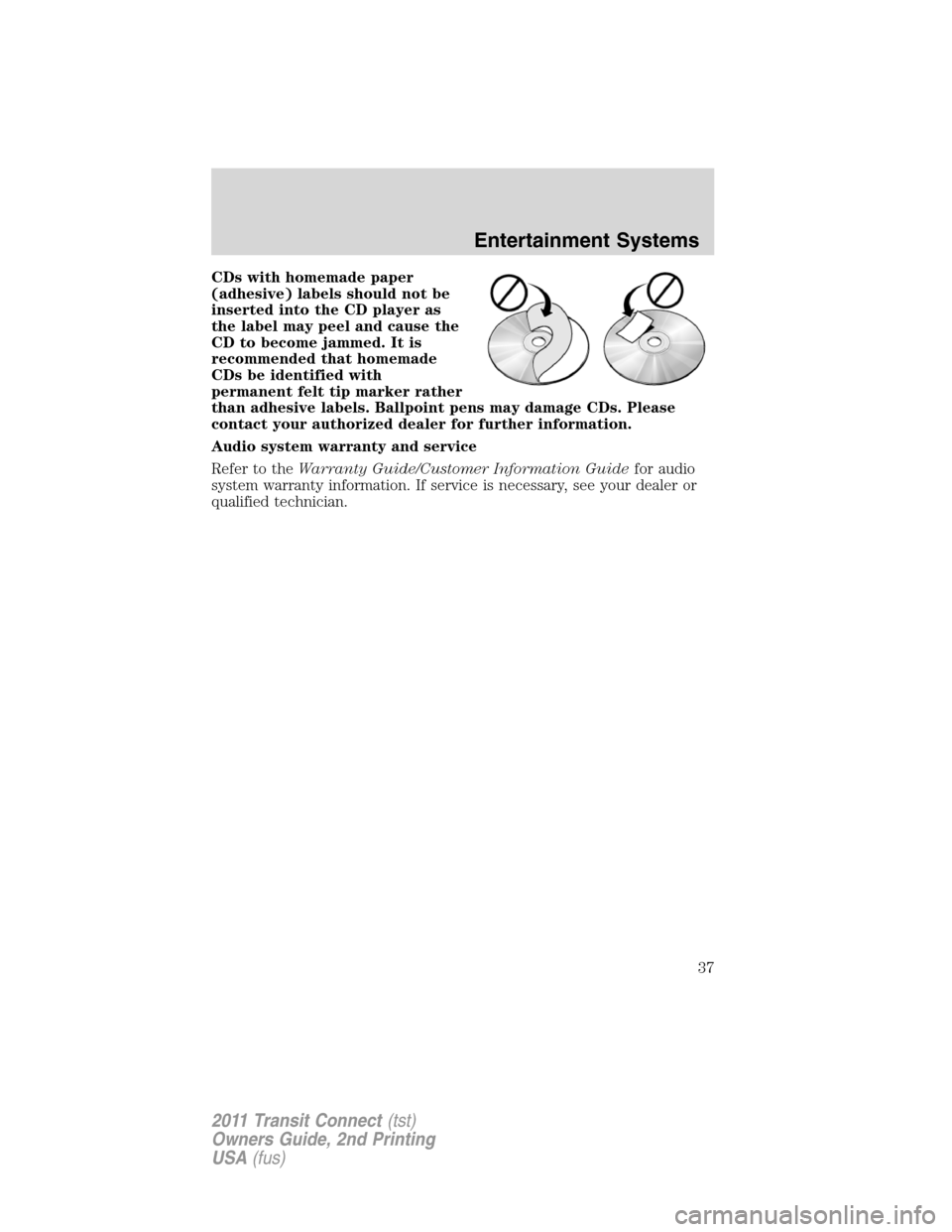
CDs with homemade paper
(adhesive) labels should not be
inserted into the CD player as
the label may peel and cause the
CD to become jammed. It is
recommended that homemade
CDs be identified with
permanent felt tip marker rather
than adhesive labels. Ballpoint pens may damage CDs. Please
contact your authorized dealer for further information.
Audio system warranty and service
Refer to theWarranty Guide/Customer Information Guidefor audio
system warranty information. If service is necessary, see your dealer or
qualified technician.
Entertainment Systems
37
2011 Transit Connect(tst)
Owners Guide, 2nd Printing
USA(fus)
Page 38 of 295
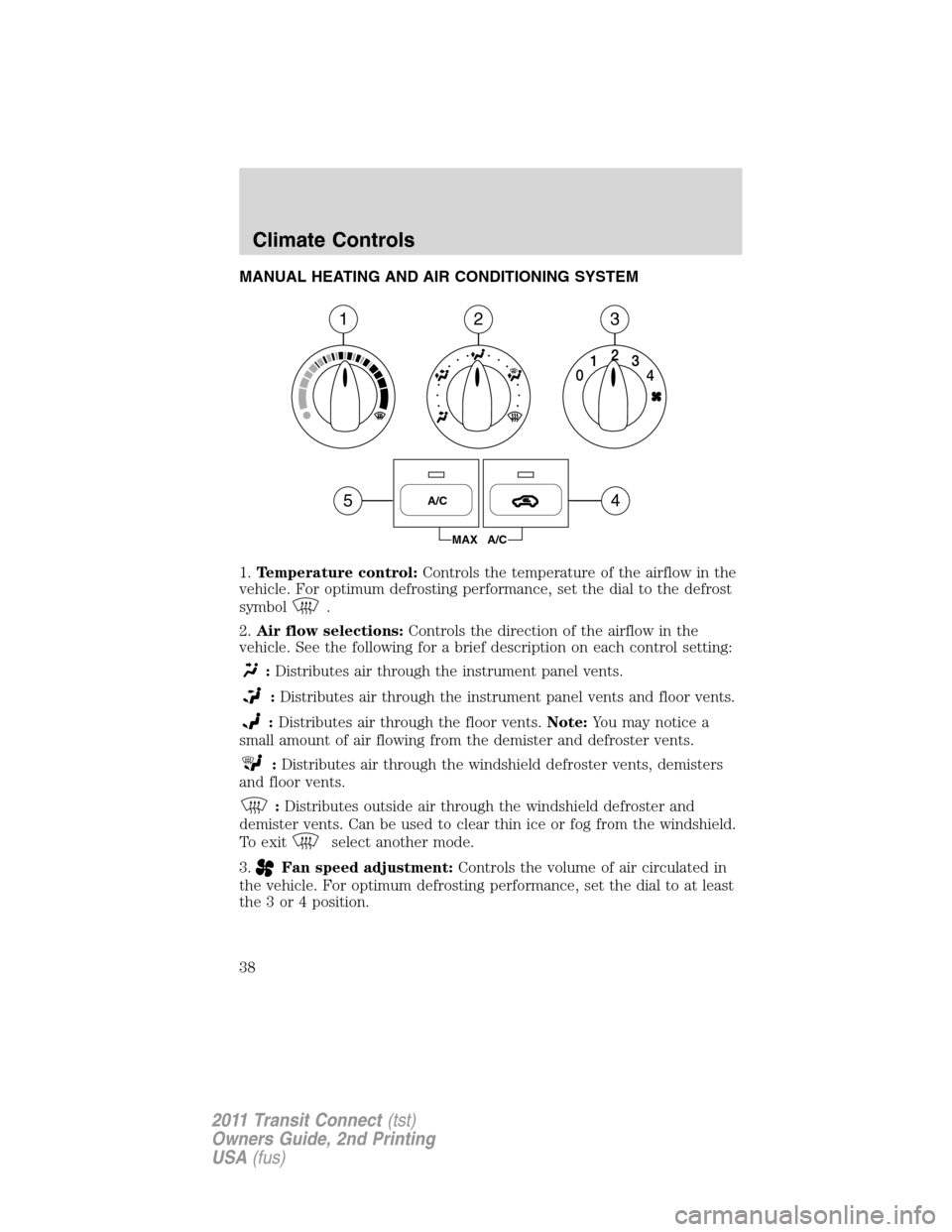
MANUAL HEATING AND AIR CONDITIONING SYSTEM
1.Temperature control:Controls the temperature of the airflow in the
vehicle. For optimum defrosting performance, set the dial to the defrost
symbol
.
2.Air flow selections:Controls the direction of the airflow in the
vehicle. See the following for a brief description on each control setting:
:Distributes air through the instrument panel vents.
:Distributes air through the instrument panel vents and floor vents.
:Distributes air through the floor vents.Note:You may notice a
small amount of air flowing from the demister and defroster vents.
:Distributes air through the windshield defroster vents, demisters
and floor vents.
:Distributes outside air through the windshield defroster and
demister vents. Can be used to clear thin ice or fog from the windshield.
To exit
select another mode.
3.
Fan speed adjustment:Controls the volume of air circulated in
the vehicle. For optimum defrosting performance, set the dial to at least
the 3 or 4 position.
54A/C
MAX A/C
231
Climate Controls
38
2011 Transit Connect(tst)
Owners Guide, 2nd Printing
USA(fus)
Page 39 of 295
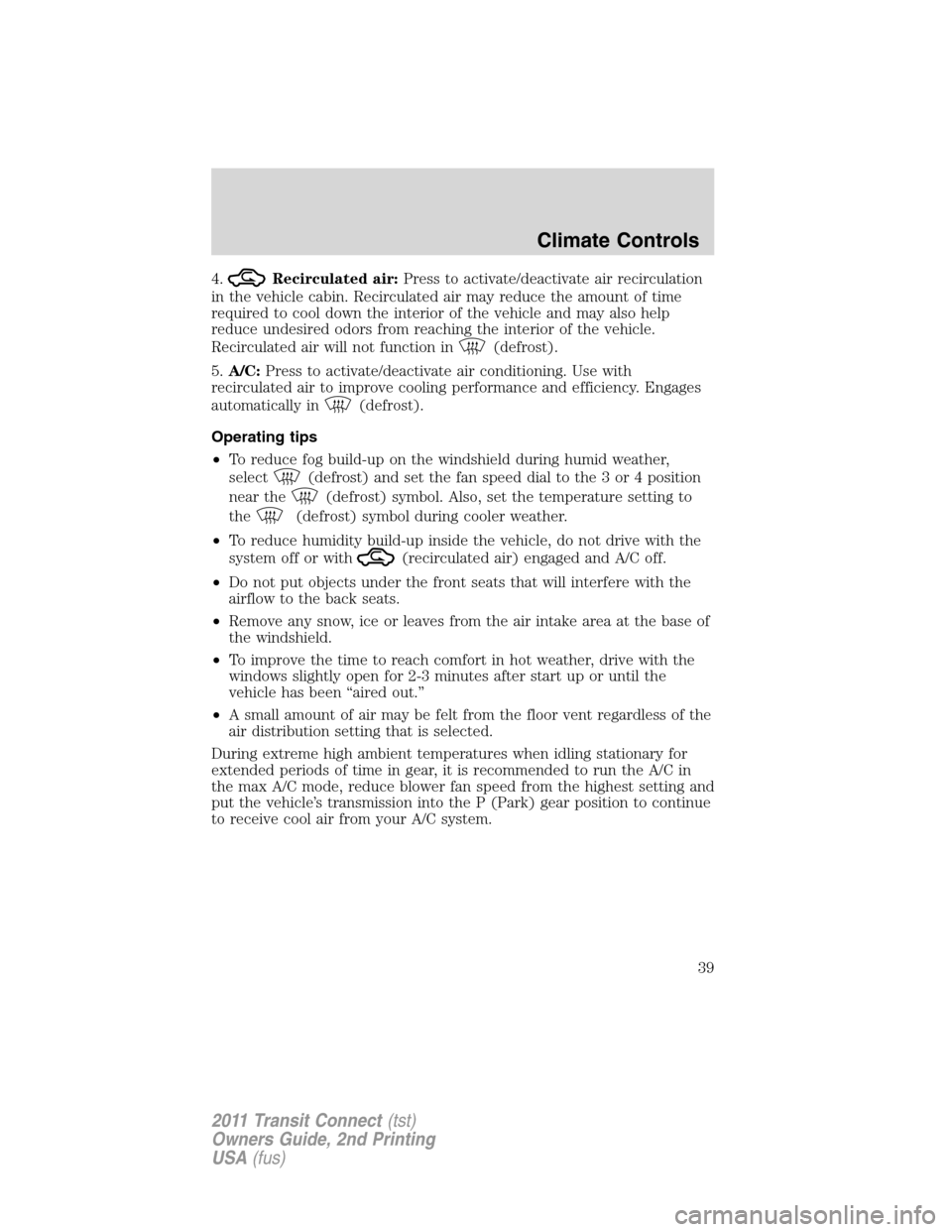
4.Recirculated air:Press to activate/deactivate air recirculation
in the vehicle cabin. Recirculated air may reduce the amount of time
required to cool down the interior of the vehicle and may also help
reduce undesired odors from reaching the interior of the vehicle.
Recirculated air will not function in
(defrost).
5.A/C:Press to activate/deactivate air conditioning. Use with
recirculated air to improve cooling performance and efficiency. Engages
automatically in
(defrost).
Operating tips
•To reduce fog build-up on the windshield during humid weather,
select
(defrost) and set the fan speed dial to the 3 or 4 position
near the
(defrost) symbol. Also, set the temperature setting to
the
(defrost) symbol during cooler weather.
•To reduce humidity build-up inside the vehicle, do not drive with the
system off or with
(recirculated air) engaged and A/C off.
•Do not put objects under the front seats that will interfere with the
airflow to the back seats.
•Remove any snow, ice or leaves from the air intake area at the base of
the windshield.
•To improve the time to reach comfort in hot weather, drive with the
windows slightly open for 2-3 minutes after start up or until the
vehicle has been “aired out.”
•A small amount of air may be felt from the floor vent regardless of the
air distribution setting that is selected.
During extreme high ambient temperatures when idling stationary for
extended periods of time in gear, it is recommended to run the A/C in
the max A/C mode, reduce blower fan speed from the highest setting and
put the vehicle’s transmission into the P (Park) gear position to continue
to receive cool air from your A/C system.
Climate Controls
39
2011 Transit Connect(tst)
Owners Guide, 2nd Printing
USA(fus)
Page 40 of 295
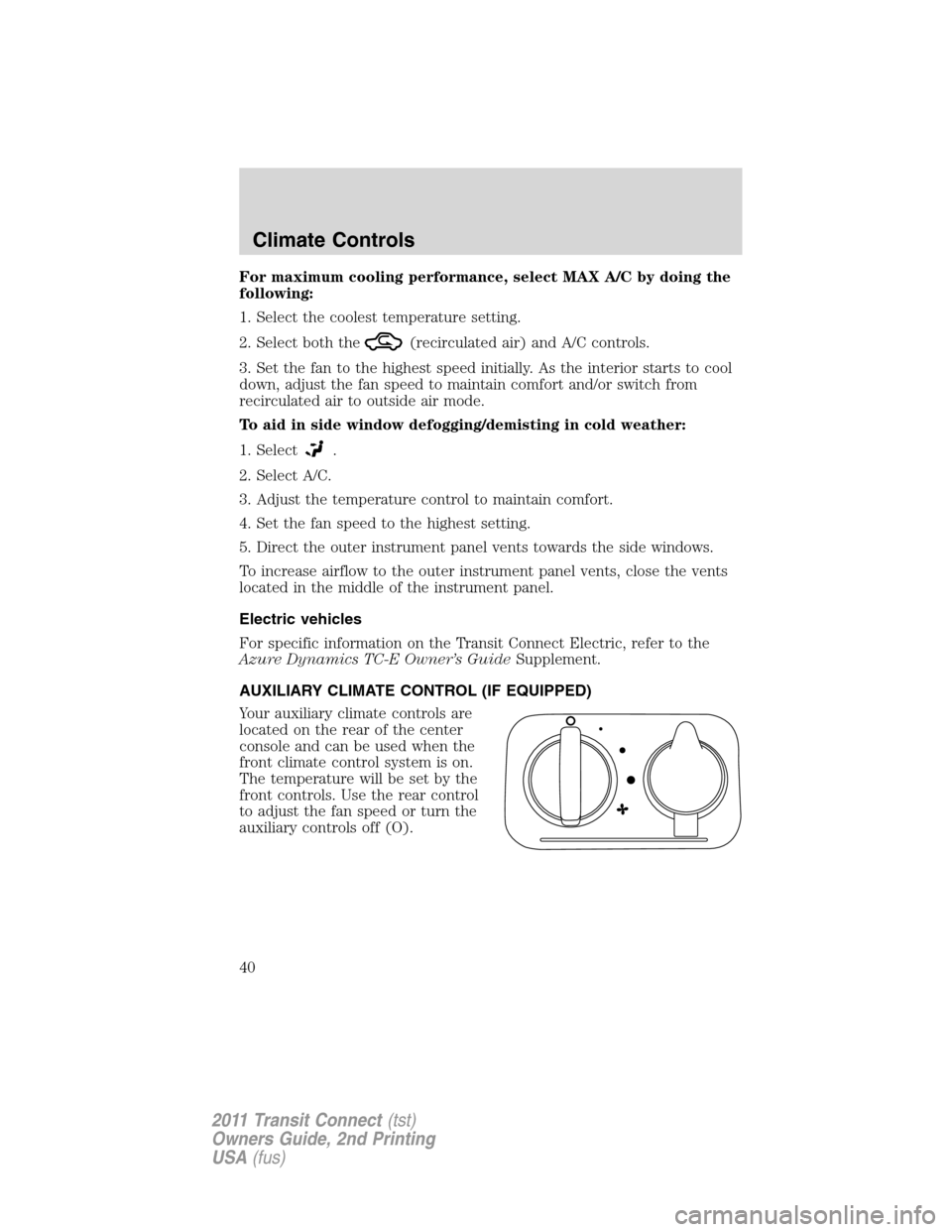
For maximum cooling performance, select MAX A/C by doing the
following:
1. Select the coolest temperature setting.
2. Select both the
(recirculated air) and A/C controls.
3. Set the fan to the highest speed initially. As the interior starts to cool
down, adjust the fan speed to maintain comfort and/or switch from
recirculated air to outside air mode.
To aid in side window defogging/demisting in cold weather:
1. Select
.
2. Select A/C.
3. Adjust the temperature control to maintain comfort.
4. Set the fan speed to the highest setting.
5. Direct the outer instrument panel vents towards the side windows.
To increase airflow to the outer instrument panel vents, close the vents
located in the middle of the instrument panel.
Electric vehicles
For specific information on the Transit Connect Electric, refer to the
Azure Dynamics TC-E Owner’s GuideSupplement.
AUXILIARY CLIMATE CONTROL (IF EQUIPPED)
Your auxiliary climate controls are
located on the rear of the center
console and can be used when the
front climate control system is on.
The temperature will be set by the
front controls. Use the rear control
to adjust the fan speed or turn the
auxiliary controls off (O).
Climate Controls
40
2011 Transit Connect(tst)
Owners Guide, 2nd Printing
USA(fus)